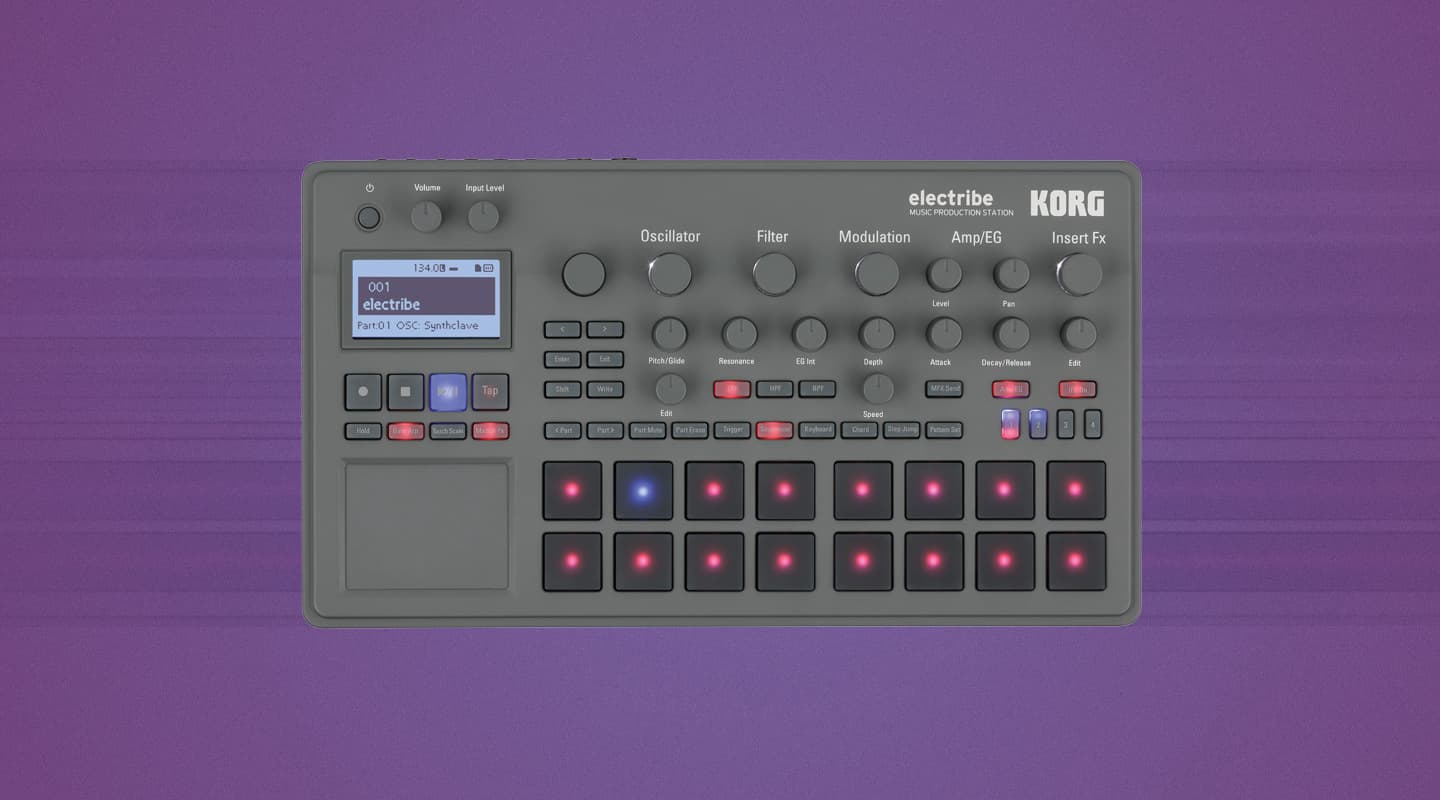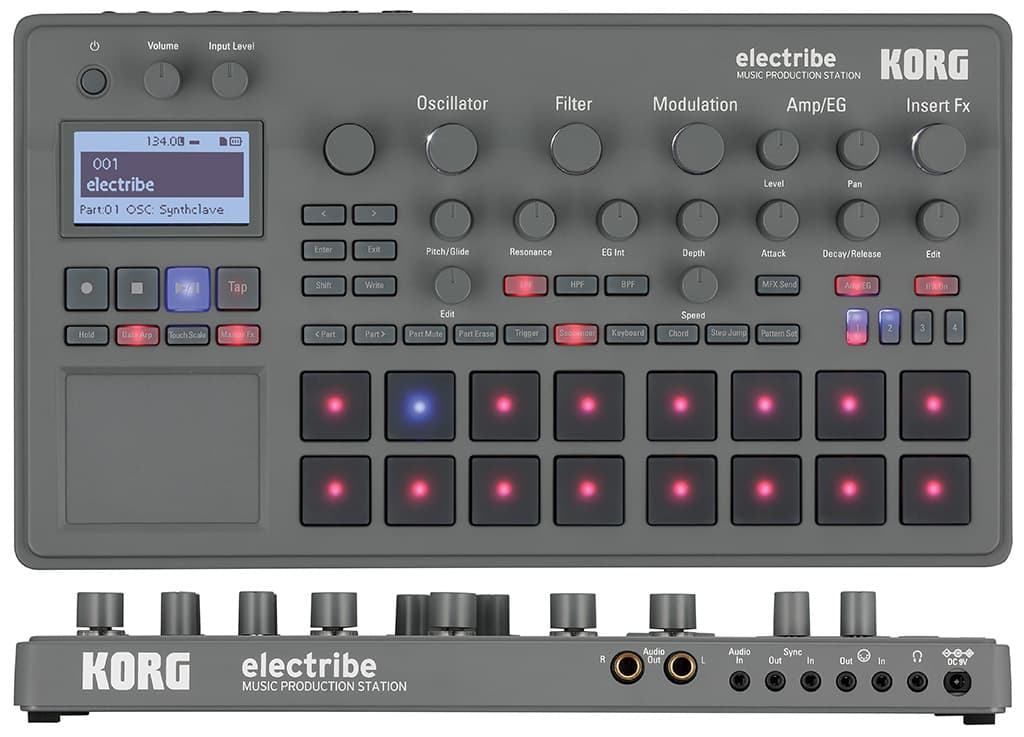
Review: Korg Electribe
Korg’s analogue modelled, drums ’n’ synth music production workstation returns. Good times.
Korg has cornered the ‘fun’ market. I’m not saying it entirely owns the groove box market — Roland’s AIRA gear has been met with considerable sales and acclaim — but no one does fun like Korg: Monotribe, Monotron, Volca… even the more ‘serious’ MS20 reissue, Korg has an array of funky little boxes of fun.
And now it has the Electribe.
Actually, correction, it’s had the Electribe since last century. I should know, I bought the EA-1 and ER-1 way back when.
This was in the comparatively early days of analogue modelling. The monophonic Korg Prophecy was still around, Roland had only just released the JP8000 and the Nord Lead was still one of the most desirable synths in the world.
So my most immediate attraction to Electribe was having access to Korg’s modelled analogue sounds in an affordable box. But I soon fell in love with the format.
Here was a fun series of modelled analogue boxes that channelled the spirit of the classic bass synth/drum synth of the analogue heyday (think: Roland TR606 Drumatix and the TB303 Bassline combo). Sync them up with a DIN cable and let rip. Instant fun.
I got my money’s worth out of my Electribes, but most of it was spent jamming rather than incorporating them into many finished tracks. The beauty of them was being able to bang great-sounding loops together. Their effectiveness was diminished if you were to address them like another passive MIDI synth. It would invariably mean sending MIDI program changes from your sequencer to trigger patterns on the Electribe. Technically, not a big deal, but, still, the Electribes always felt like they were operating a little in parallel with the rest of your studio.
QUICK OFF THE LIGHTS
I thought I’d dust off the ol’ Electribes in celebration of the arrival of the latest hipster upstart.
Out of the box, the latest Electribe is sleek and relatively unadorned. Switch it on and it’s like a Tokyo Drift hot hatch. All LED skirts and halos. Trés schmick.
The factory preset loops are impressive. The sound is instantly contemporary, exploring all the various latest strands of EDM — dub step, trap, main floor, along with traditional dancefloor favourites like trance, house and techno — and demonstrate how you can build variations and fills. It’s all very impressive, and not in a “yeah, but it needs some kind of polysynth for this loop to sound any good” kind of way — straight out of the box, the Electribe feels like a fully-formed floor filler.
Here’s why: there’s plenty of polyphonic grunt. The Electribe packs drums and synthesis in the same box and, all up, there’s a maximum of 24 simultaneous voices possible. And to bump up the depth, you can convert any sound you like into a chord — just hit the Chord button to use the keypad to trigger chords according to which scale mode you’re set to. Of course, you can do it the old fashioned way and simply hit multiple buttons on the keypad in Keyboard mode. The point is, with this amount of polyphony, really quite rich productions are possible.
NEED TO KNOW

GOING THROUGH MOTION
That sort of rich palette of sounds and textures is a good thing, but only if it doesn’t come at the expense of usability, and in my view for a music production station such as Electribe, simplicity of use is just about the single most important feature. To its credit, Electribe is fall-off-a-log easy. The manual is only 15 pages long, for goodness sake! This all belies the fact there’s enormous scope for fashioning something that’s truly your own.
Motion Sequencing, for example, makes a welcome reappearance in this manifestation of Electribe. It’s a feature that allows you to record your knob tweaking and save it as part of that pattern. Nifty.
Motion sequencing may have been my favourite feature of the old-school Electribes but I think the gate arpeggiator is probably my new best friend. It allows you to use the XY pad to trigger the sequencer with gate speed on one axis and length of sound on the other. A great real-time performance tool, and, yes, you can record that too.
There are a couple of other features that mean you’ll want to take Electribe with you on stage. For example, there’s no need to scroll through patterns, you can assign them to the keypads for easier triggering and you can return to the XY pad for some real-time sonic wig outs with the Touch Scale button.
FILTER FREAK
Sonically, Electribe is everything you’d expect from a Korg analogue modelling synth. There is a selection of the latest and greatest filters on board — MS20, Oberheim, ‘Acid’ and more — and if squealing self oscillation is your bag, you’ve come to the right place.
A big chunk of an Electribe sound is down to its effects and Korg provides more than enough flexibility on this front. Not only do you have a master effect, you can apply an insert effect. The effects themselves are monstrous. The first FX patches point the way (a distortion and a bit crusher-style effect) and, along with delays, modulation effects etc, they’re all programmed to be cranked to the point of absurdity.
KEEP IT SIMPLE
The success of the Electribe is down to the right combination of big sound, and ease of use. The interface has just enough buttons to ensure you can spend 90 percent of your time playing without recourse to the LCD. Great. But there’s enough sophistication and grunt to ensure you can produce loops that stand on their own two feet.
Saying that, if you were to make the Electribe part of your stage setup, it needs to be a team player. Korg makes it easy to sync with its analogue Volcas via dedicated sync jacks or indeed any other device via MIDI (peculiarly MIDI I/O is via a jack socket that needs a special, supplied, jack-to-DIN lead you wouldn’t want to lose or forget to take to the gig).
Back in the day of the original Electribes no one had the nerve to take anything other than an Akai MPC on stage and Ableton was still just another product Applied Acoustics made. I wouldn’t hesitate making today’s Electribe a key part of my stage setup. A sound that’s totally up to date, in a fun package you can’t help but reach out and make your own.
As for my ‘legacy’ Electribes? Well, they’re not going to be inducted into a synth hall of fame anytime soon or allow me to retire on the resale proceeds. That’s okay. I enjoyed my years with the EA-1 and ER-1 and I have no hesitation in predicting the same future for the 2014 Electribe — fun and inspiring.

















RESPONSES